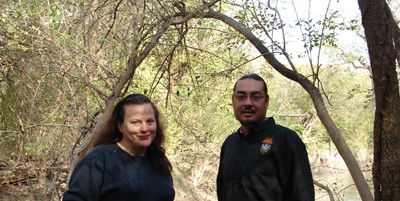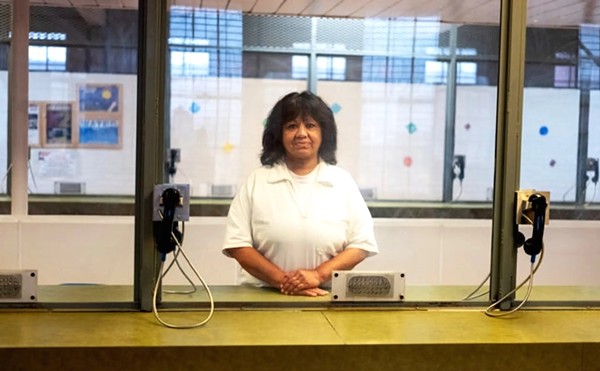Twelve-hundred acres along the south bank of the Medina River just inside Loop 1604 flout the hardcore realist who says there is no such thing as divine
intervention. Think of all the times the well-deserved letter of clemency didn’t arrive in time, you say, that no happy synergy speeded a pardon ahead of the executioner’s hand. And yet, somewhere in that brambly, undeveloped tract of cypress, persimmon bush, and juniper, vast by urban standards, something chuckles gently at those of us who doubt that even one spirit that thrived in this long-gone crossroads kept watch with dam engineering-inspector Richard Beene the day he saved one of the richest archeological sites in North America from a spillway trench for the ill-fated Applewhite Reservoir.
“The bellyscrapers were scraping by and they were 16 feet beneath the surface, and he saw all over the ground the remains of these campfires and the remains of these mussel shells,” recalls Texas A&M archeologist Alston Thoms, who was working nearby on the property in 1990 when Beene raised the alarm. “Had he waited 15 minutes, at the rate those bellyscrapers were going, `the evidence` would have been gone.”
The grass has grown in during the intervening 18 years, and the earth sits quiet, waiting for the City to catalyze its next phase in a long, remarkable history of human use.
City Council is expected to vote in February to transfer the former Applewhite property to the Land Heritage Institute, a nonprofit coalition of historic preservationists, tribal representatives, naturalists, and archeologists who plan to develop it into a facility of interrelated living-history and artifacts exhibits, nature trails and primitive campsites, and open-air classrooms. The blueprint includes a working Hispanic rancho, equestrian trails, Native American cultural functions, birdwatching, and ongoing excavations and study of the Beene area, all for an initial investment of around $1 million. This ambitious layering of activities roughly mirrors the people that left their mark on this segment of the old Texas Camino Real — but the human footprint extends back to the beginnings of culture in North America.
“That’s what’s made the Land Heritage Institute’s scope important for us,” says City of San Antonio Parks and Recreation Director Malcolm Matthews, “that they want to take all that information and make something of it, tell the story of how that land has been used in this area over the last several-thousand years.”
It’s a story long dominated by Spanish missionaries, Mexican revolution, Texican intrigue, and U.S. expansion, but the quality of the finds on the LHI site are dramatically changing our understanding of the history of South Texas.
“What we have `at LHI` are the remains of 10,000 years of family encampments along the Medina River,” says Thoms, who led a team of researchers in evaluating the site’s potential for the LHI proposal. Already the excavations have turned up food remains such as deer- and rabbit-size animal bones, cookstone or fire-crack rock, projectile points, and woodworking tools.
The river regularly flooded the area, leaving silt in its wake, and Thoms and his team found artifacts in well-preserved, distinct layers. “I’ve been doing archeology for almost 40 years and nowhere have I ever worked where you could walk along these river banks and reach out and touch the remains of these encampments 10,000 years old,” he says. Some of the most exciting discoveries to date include barbacoa-style fireless pits, and “family-size cooking features” dating from 7,000 years ago that, Thoms says, you could argue were inside homes. The shelters, he adds, appear to be dome-shaped structures of the type that the Spanish explorer Cabeza de Vaca recorded seeing in the area in the first half of the 16th century.
Ramon Vasquez, an LHI permanent director and representative of the American Indians-Texas at Spanish Colonial Missions, found the oldest artifact yet on the site — a mammoth femur bone dated to around 12,000 years ago that shows signs of being worked by humans. But that’s not the only reason the site is deeply meaningful to Vasquez, whose organization represents descendants of the North American tribes colonized by the Spanish missionaries. As he takes LHI board member Penelope Boyer and me on a guided tour of the property on a sunny December morning, he talks of reclaiming his people’s history from science, which has too often catalogued it according to its own prejudices and priorities. “Historically we’re the cultually affiliated tribal people that were on that property, and so it’s another piece of our story as a people that needs to be shared,” says Vasquez. “From this point on we will be working with archeologists and researchers ... we will be a direct part of how the story will be told and interpreted.”
Vasquez is not as interested in the romanticization of the past, he says, as he is in its potential for building a better future. One of the initiatives he is most excited about is a grant application submitted in partnership with Thoms to study the native diets and their role in healthy lifestyles and disease prevention.
“`The site` shows a continuity from the prehistoric past right up to the Mission Indians and their descendants today,” says Thoms, and the LHI coalition plans to evoke as much of that history as it can. The first stage of development includes rehabilitating the circa-1853 Presnall Watson farmstead into a living-history exhibit of mid-19th to early 20th-century South Texas ranch life. During the second phase, a working hacienda, Rancho del Rio Medina, will be built next to an existing 18th-century ruin to demonstrate the period’s Spanish-Mexican ranching culture, paying tribute in part to another former occupant of the land, Spanish governor Juan Ignacio Pérez.
In addition to Vasquez, LHI’s board includes representatives of the Tap-Pilam Coahuiltecan Nation, and a descendant of one of the families that farmed the land through the early 20th century. For Matthews this is yet another reason that the LHI — forged in the late ’90s from disparate groups in a series of meetings and a San Antonio Water System design roundtable, is the right organization to develop this cultural resource. “They’ve got historical background of people who lived in that area on their board; the different open-space and natural-resource people are on their board,” says Matthews. “So they really put together a good team. Now it’s just a matter of getting started.”
After years of negotiation, complicated and then enriched by Toyota, which contributed a buffer strip along the riverbank from its plant across the Medina, and retains land-use approval rights under its contract with the city, the project is scheduled to finally get started later this month. The transfer of the property from the City to LHI starts a funding clock: In order to retain title to the land, LHI needs to meet two five-year benchmarks, which will introduce development in stages, beginning with restoring and modifying buildings already on the property.
At the same time, the City will be building a hike-and-bike trail that will extend from Medina River Park to the west, through the LHI property, to nearby Mitchell Lake Audubon Center, creating a band of greenspace and wildlife unequaled in the city.
Of course, San Antonians have more than luck or coincidence to thank for this slowly emerging treasure. It was the voters, after all, who twice rejected plans to flood the area for a shallow reservoir that critics said would hardly float a child’s sailboat during a hot summer. If opposition groups, in part mobilized by the land’s historic importance, hadn’t mounted successful petition drives and referenda in ’91 and ’94, the Beene site would be a chapter in a historic textbook, a collection of artifacts in a distant museum. If the council vote proceeds as Matthews and enthusiastic District 8 Councilwoman Diane Cibrian expect it to, the City will finally entrust the land to the public who all those years ago, with the help of a keen-sighted engineer, laid claim to it. •
Proposed site development
1. Archeology Center
2. Presnall Watson Living History Museum
3. AIT Cultural Center
4. Equestrian Complex
5. El Rancho del Rio Medina
6. Agricultural Research Center
7. Caminos Naturales
________________________________________________
For detailed information on the archeological finds at the Richard Beene site and an exhibit about Cabeza de Vaca, visit http://www.texasbeyondhistory.net/beene/index.html , both of which were created in partnership with Alston Thoms. The site also offers engaging and informative educational materials for K-12 at http://www.texasbeyondhistory.net/beene/digging/index.php. Many thanks to site co-editor Susan Dial, who wrote the Current about these resources, including the "'Doorways to the Past' interactive, where students click on 'doors' in the stratigraphic layers to see scenes of life along the Medina over 15,000 years, from mammoth hunters to the time of the Presnall and Watson families, as well as examples of the archeological evidence that informs the interpretations." Thoms calls it "one of the best archeological websites on earth." Visit and see for yourself.


















